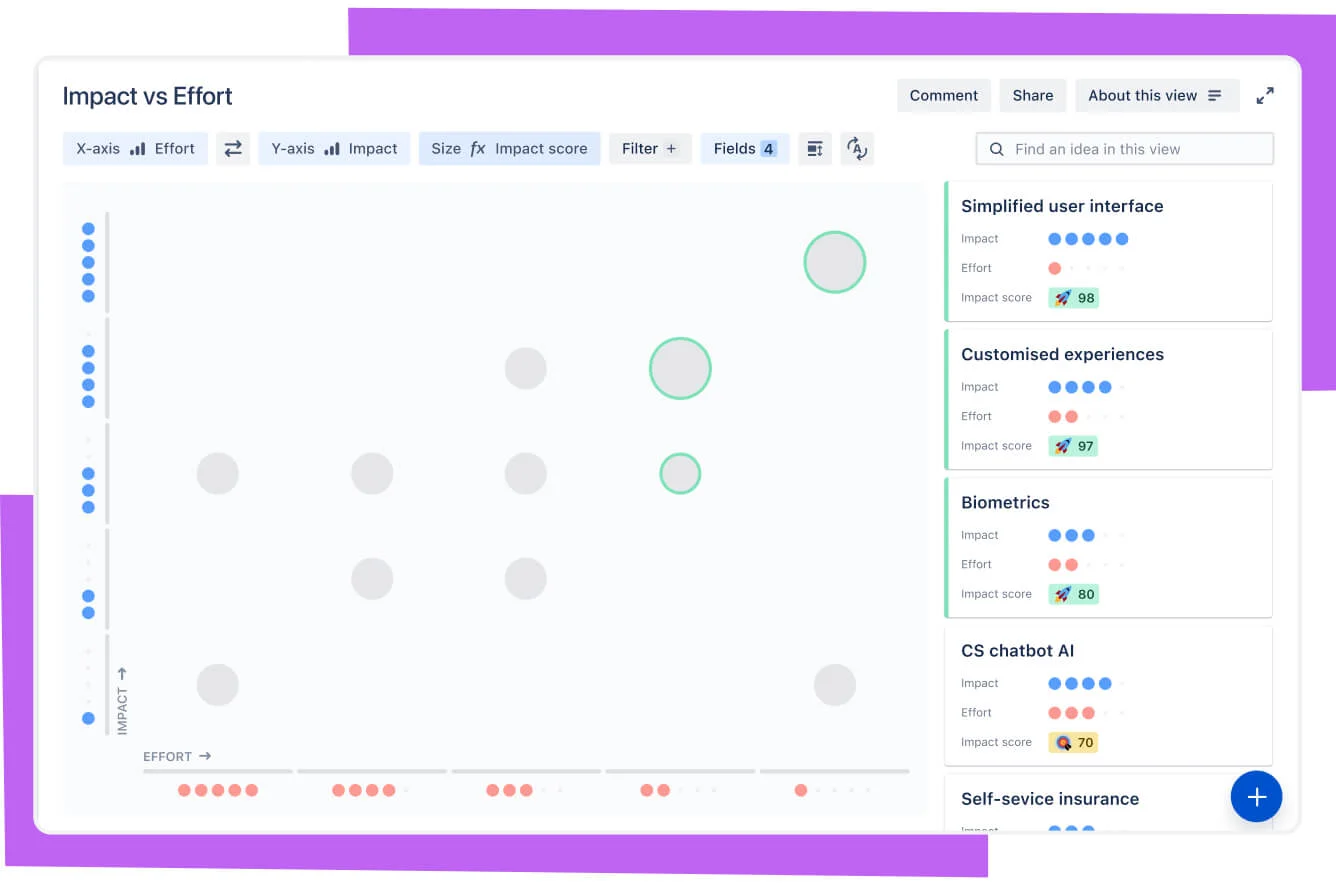Ein gut priorisiertes agiles Backlog vereinfacht nicht nur die Release- und Iterationsplanung, sondern beinhaltet alle Aufgaben für dein Team – einschließlich interner Aufgaben, die der Kunde nie zu sehen bekommt. Das Backlog hilft, Erwartungen von Stakeholdern und anderen Teams einzudämmen, wenn diese zusätzliche Aufgaben an das Team herantragen, und macht die Entwicklungszeit zu einer festen Ressource.
Was ist ein Product Backlog?
Ein Produkt-Backlog ist eine priorisierte Liste von Aufgaben für das Entwicklerteam, die von der Produkt-Roadmap und ihren Anforderungen abgeleitet wird. Die wichtigsten Elemente werden im oberen Bereich des Produkt-Backlogs angezeigt, damit das Team weiß, woran es zuerst arbeiten muss. Das Entwicklerteam arbeitet sich nicht in der vom Produktinhaber vorgegebenen Geschwindigkeit durch das Backlog, und der Produktinhaber verteilt keine Aufgaben an das Entwicklerteam. Stattdessen entnimmt das Entwicklerteam Aufgaben aus dem Produkt-Backlog, wenn die Kapazität dafür vorhanden ist – entweder kontinuierlich (Kanban) oder nach Iteration (Scrum).
Im Scrum-Framework ist das Scrum-Produkt-Backlog eine strukturierte und sorgfältig gepflegte Liste, die dem Scrum-Produktinhaber als Guide für die Aufgaben des Entwicklungsteams dient.

Nutze einen einzigen Issue Tracker für alle Aufgaben – und nicht mehrere Systeme, um Bugs, Anforderungen und einzelne Entwicklungsaufgaben zu verfolgen. Bewahre alle Aufgaben für das Entwicklerteam in einem einzigen Backlog auf.
Vorteile eines Produkt-Backlogs
Ein gut verwaltetes Produkt-Backlog bringt einem Entwicklungsteam zahlreiche Vorteile. Zu den Hauptvorteilen zählen:
- Verbesserte Priorisierung: Ein Produkt-Backlog hilft dabei, dass die wichtigsten Aufgaben zuerst bearbeitet werden.
- Höhere Effizienz: Durch die Priorisierung von Aufgaben auf der Grundlage von Kundenfeedback und Geschäftszielen können Teams dafür sorgen, dass sie an den wertvollsten Aufgaben arbeiten.
- Bessere Kommunikation: Dank eines Produkt-Backlogs ziehen alle an einem Strang und arbeiten auf dieselben Ziele hin.
- Gezielterer Einsatz: Indem Teams Aufgaben auf der Grundlage von Kundenfeedback und Geschäftszielen priorisieren, können sie zielgerichteter wirken und dafür sorgen, dass sie nicht an Aufgaben ohne Mehrwert arbeiten.
- Verbesserte Kundenzufriedenheit: Indem Teams Aufgaben auf der Grundlage von Kundenfeedback priorisieren, realisieren sie die von den Kunden gewünschten Features und Funktionen.
Insgesamt ist ein gut verwaltetes Produkt-Backlog unerlässlich für eine agile Produktentwicklung. Es sorgt dafür, dass die Teams an den wertvollsten Aufgaben arbeiten und dass alle an einem Strang ziehen und auf dieselben Ziele hinarbeiten.
Starte ein Produkt-Backlog mit den beiden "R"s
Die Roadmap und die Anforderungen eines Teams bilden die Grundlage für das Produkt-Backlog. Roadmap-Initiativen werden in mehrere Epics unterteilt, die wiederum mehrere Anforderungen und User Storys umfassen. Sehen wir uns die Roadmap für ein fiktives Produkt namens "Teams in Space" an.
Da die "Teams in Space"-Website die erste Initiative in der Roadmap ist, wird diese Initiative in Epics (hier in Grün, Blau und Türkis dargestellt) und User Storys für die einzelnen Epics unterteilt.
Der Product Owner organisiert für das Entwicklerteam alle User Storys in einer einzigen Liste. Er entscheidet möglicherweise, zunächst ein vollständiges Epic bereitzustellen (links). Vielleicht muss mit dem Programm aber auch das Buchen eines vergünstigten Flugs getestet werden und dafür sind Storys aus mehreren Epics erforderlich (rechts). Beide Beispiele sind unten dargestellt.
Welche Aspekte können die Priorisierung des Product Owners beeinflussen?
- Kundenpriorität
- Dringlichkeit, Feedback zu erhalten
- Relative Implementierungsschwierigkeiten
- Symbiotische Beziehungen zwischen Aufgabenelementen (z. B. wenn B einfacher durchzuführen ist, nachdem A abgeschlossen wurde)
Durch eine effektive Priorisierung des Produkt-Backlogs werden die wichtigsten Aufgaben zuerst angegangen, wodurch die Teamautonomie mit den Anforderungen des Produktinhabers in Einklang gebracht wird.
Die Priorisierung des Backlogs fällt zwar in die Verantwortung des Produktinhabers, erfolgt aber nicht in einem Vakuum. Effektive Produktinhaber berücksichtigen Input und Feedback von Kunden, von Designern und vom Entwicklerteam, um die Arbeitsauslastung aller Beteiligten und die Produktbereitstellung zu optimieren.
Erstellen eines Produkt-Backlogs
Das Erstellen eines Produkt-Backlogs ist ein entscheidender Schritt in der agilen Produktentwicklung. Dabei wird auch eine Produkt-Roadmap erstellt, die Elemente aus dem Produkt-Backlog werden aufgelistet und mit dem Team kommuniziert.
Eine Produkt-Roadmap erstellen
Eine Produkt-Roadmap ist ein übergeordneter Plan, der die Vision, Ziele und Zielsetzungen des Produkts umreißt. Sie dient als Grundlage für den Produkt-Backlog und hilft dabei, sicherzustellen, dass alle an einem Strang ziehen und auf dieselben Ziele hinarbeiten.
Definiere zum Erstellen einer Produkt-Roadmap die Vision und Mission des Produkts. Ermittle dann die wichtigsten Zielsetzungen und die zu erreichenden Vorgaben. Teile schlussendlich die Zielsetzungen in kleinere, überschaubare Aufgaben auf, die sich zum Produkt-Backlog hinzufügen lassen.
Auflisten der Elemente im Produkt-Backlog
Nach dem Fertigstellen der Produkt-Roadmap ist es an der Zeit, Elemente aus dem Produkt-Backlog aufzulisten. Diese Elemente können Funktionen, User Storys, Fehler, Designänderungen und technische Schulden beinhalten.
Wenn du Elemente aus dem Produkt-Backlog auflistest, ergänze eine klare Beschreibung jedes Elements und alle relevanten Details, wie etwa die geschätzte benötigte Zeit und die erforderlichen Ressourcen. Es ist auch wichtig, die Elemente auf der Grundlage von Kundenfeedback, Anfragen und Geschäftszielen zu priorisieren. Auf diese Weise arbeitet das Entwicklungsteam an Aufgaben, die den größten Nutzen bringen.
Kommunikation mit dem Team
Effektive Kommunikation ist beim Erstellen eines Produkt-Backlogs entscheidend. Der Produktinhaber sollte eng mit dem Entwicklungsteam zusammenarbeiten, damit jeder den Produkt-Backlog und die Prioritäten versteht. Der Produktinhaber sollte auch mit anderen Teams wie Vertrieb und Marketing kommunizieren, sodass alle an einem Strang ziehen und auf dieselben Ziele hinarbeiten.
Regelmäßige Meetings und Updates stellen sicher, dass alle auf demselben Stand sind und dass der Produkt-Backlog effektiv verwaltet wird.
Brauchst du noch weitere Anleitung? Sieh dir die kostenlose Produkt-Backlog-Vorlage von Jira an.
Ein Produkt-Backlog priorisieren

Die Priorisierung des Backlogs ist unerlässlich, damit sich das Entwicklungsteam auf Aufgaben mit maximaler Wirkung konzentriert. So packst du das am besten an:
Verschiedene Techniken zur Priorisierung von Backlogs, wie MoSCoW und gewichtetes Scoring, können Teams bei der effektiven Verwaltung und Anordnung von Aufgaben unterstützen. Der Priorisierungsprozess beinhaltet die regelmäßige Überprüfung und Neuausrichtung der Ziele für die Anpassung an ein dynamisches Geschäftsumfeld.
Schritt 1. Die Bedürfnisse der Kunden bewerten
- Identifiziere Funktionen oder Problembehandlungen mit dem höchsten Wert für deine Nutzer.
- Lege Prioritäten anhand von Kundenfeedback, Umfragen oder Analysen fest.
Schritt 2. Die Dringlichkeit von Feedback beurteilen
- Priorisiere die Elemente, die umsetzbare Einblicke für das Team oder die Stakeholder generieren.
- Wenn du beispielsweise eine neue Funktion frühzeitig testest, kannst du später Zeit und Ressourcen sparen.
Schritt 3. Die Komplexität der Implementierung bedenken
- Gleiche deinen Backlog aus, indem du schnelle Erfolge und komplexere, langfristige Projekte einbeziehst.
- Wäge das Verhältnis von Aufwand zur Wirkung ab, damit Ressourcen sinnvoll eingesetzt werden.
Schritt 4. Abhängigkeiten berücksichtigen
- Identifiziere Aufgaben, die abgeschlossen werden müssen, bevor du mit anderen fortfahren kannst.
- Rationalisiere Workflows, indem du zuerst grundlegende Arbeiten erledigst.
Zuverlässige Tools, welche die Priorisierung von Backlogs unterstützen, können die Produktentwicklung rationalisieren und die Effizienz steigern. Während der Produktinhaber die Priorisierung leitet, fördert die Einbindung des Entwicklungsteams, der Designer und der Stakeholder ein gemeinsames Verständnis der Prioritäten. Regelmäßige Diskussionen verbessern die Abstimmung und die Entscheidungsfindung.
Profitipp: Nutze Frameworks zur Priorisierung wie MoSCoW (Must-have, Should-have, Could-have und Won’t-have) oder gewichtetes Scoring, um objektive, datengestützte Entscheidungen zu treffen. Teams können mithilfe der flexiblen Priorisierungsfunktion in Jira Product Discovery ganz eigene, einzigartige Frameworks zur Priorisierung implementieren.
So verwaltest du Produkt-Backlogs effektiv
Nach dem Erstellen eines Produkt-Backlogs geht es um dessen Pflege, damit das Programm regelmäßig auf dem neuesten Stand bleibt. Produktinhaber sollten das Backlog vor jedem Iterationsplanungsmeeting überprüfen und sicherstellen, dass die Priorisierung nach wie vor korrekt ist und das Feedback der letzten Iteration berücksichtigt wurde. Ein regelmäßiges Backlog-Review, in agilen Kreisen oft als Produkt-Backlog-Refinement bezeichnet, sorgt dafür, dass die Aufgaben mit den Einblicken der Stakeholder in Einklang gebracht werden und das Team auf den bevorstehenden Sprint vorbereitet wird (einige nutzen den Begriff Backlog Refinement).
Wenn das Backlog wächst, können die Produktinhaber es in kurz- und langfristige Aufgabenelemente unterteilen. Kurzfristige Aufgabenelemente müssen vollständig ausgearbeitet werden, bevor sie als solche gekennzeichnet werden. Das heißt, User Storys wurden komplett erstellt, die Zusammenarbeit mit Design und Entwicklung ist geplant und die Entwicklung hat ihre Schätzungen abgegeben.
Längerfristige Aufgabenelemente können vage bleiben, obwohl zumindest eine grobe Schätzung des Entwicklerteams wünschenswert ist, um auch diese Aufgabenelemente priorisieren zu können. Das Schlüsselwort hier ist „grob“, da sich diese Schätzungen verändern werden, sobald das Team sie vollständig verstanden hat und mit der Arbeit daran beginnt.
Das Backlog stellt die Verbindung zwischen dem Produktinhaber und dem Entwicklerteam dar. Der Produktinhaber kann die Priorität der Aufgaben im Backlog jederzeit neu festlegen, wenn Kunden ihr Feedback übermitteln, Schätzungen neu abgestimmt werden oder neue Anforderungen entstehen. Sobald die Arbeit jedoch ausgeführt wird, sollten sich Änderungen auf ein Minimum beschränken, da sie das Entwicklungsteam stören und Fokus, Flow und Moral beeinflussen.
Profitipp: Sobald das Backlog die langfristigen Kapazitäten des Teams übersteigt, ist es okay, Vorgänge abzuschließen, für die das Team niemals Zeit haben wird. Markiere für zukünftige Recherchen diese Probleme mit einer bestimmten Lösung, wie „Out of Scope“, im Issue Tracker des Teams.
Anti-Pattern, die vermieden werden sollten
- Der Produktinhaber legt die Prioritäten im Backlog zu Beginn des Projekts fest, passt diese aber nicht an, wenn Feedback von Entwicklern und Stakeholdern zurückkommt.
- Das Team begrenzt die Elemente im Backlog auf kundenorientierte Aufgaben.
- Da das Backlog lokal gespeichert und nur selten geteilt wird, werden Aktualisierungen nicht an alle Beteiligten weitergegeben.
Agile Teams dank Produkt-Backlogs
Erfahrene Produktinhaber pflegen das Produkt-Backlog ihres Programms sorgfältig, um eine verlässliche und vom Team teilbare Übersicht der Aufgabenelemente eines Projekts bereitzustellen.
Stakeholder fechten Prioritäten an und das ist gut so. Diskussionen über die wichtigen Dinge sorgen dafür, dass die Prioritäten aller Beteiligten gleichberechtigt berücksichtigt werden. Solche Diskussionen unterstützen eine Kultur der Gruppenpriorisierung, die sicherstellt, dass alle am Programm Beteiligten auf derselben Linie sind.
Ein gut priorisiertes agiles Backlog verdeutlicht, wofür das Team Zeit aufbringen will, und hebt sichtbare und interne Aufgaben hervor. Denke daran, dass das Produkt-Backlog auch als Grundlage für die Iterationsplanung dient. Alle Aufgabenelemente sollten in das Backlog aufgenommen werden: User Storys, Fehler, Designänderungen, technische Schulden, Kundenanfragen, Aktionen aus der Retrospektive usw. Auf diese Weise kann sichergestellt werden, dass alle Aufgabenelemente für jede Iteration in die Gesamtdiskussion einbezogen werden. Die Teammitglieder können dann Kompromisse mit dem Produktinhaber eingehen, bevor sie eine Iteration beginnen, mit vollständiger Kenntnis von allem, was getan werden muss.
Profitipp: Produktinhaber legen die Priorität der Aufgabenelemente im Backlog fest, während das Entwicklerteam die Geschwindigkeit bestimmt, mit der das Backlog bearbeitet wird. Neue Produktinhaber, die Aufgaben an das Team "verteilen" möchten, können auf einem unsicheren Posten stehen. In diesem Artikel werden die Grenzwerte und der Flow für Work in Progress erklärt.
Priorisiere die wichtigen Dinge mit der Jira Scrum-Vorlage
Verschaffe dir einen vollständigen Überblick über die gesamte zu erledigende Arbeit und konzentriere dich auf die größte Wirkung.
